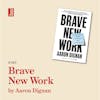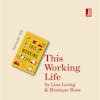Move to the Edge, Declare it Centre by Everett Harper: how to be more human in complexity
About the author
Everett Harper is the CEO and Co-Founder of Truss, a human-centered software development company, named as an Inc 5000 fastest-growing private company for 2020 and 2021.
He is a rare combination of a Black entrepreneur, Silicon Valley pedigree, National Champion, and a proven record for solving complex problems with social impact.
He had the foresight to build a company that’s been remote-first since 2011, salary-transparent since 2017, anticipating the importance of hybrid work and diversity, equity and inclusion (DEI) by a decade. Before Truss, Everett was at Linden Lab, maker of Second Life, a pioneering virtual world, and Bain and Company management consultants.
Though both his parents had pioneering careers as software programmers for IBM, Everett is the first in his family to attend college, as an A.B. Duke Scholar at Duke University. While majoring in biomedical and electrical engineering at Duke, he also won a NCAA National Championship in soccer. He was inducted into the North Carolina Soccer Hall of Fame in 2019. Everett graduated with an MBA and a M.Ed in Learning, Design and Technology from Stanford University.
In his career, he’s leveraged his education and experience to help millions of others, from helping fix healthcare.gov at Truss, fighting poverty worldwide as a Board Member of CARE, and helping low- and moderate-income homebuyers while at Self-Help, a community development finance institution.
Everett grew up a small town kid in New York’s Hudson Valley. He currently lives in Oakland, CA, making limoncello when life hands him lemons.
Source: https://www.everettharper.com/about
About the book
Lead organizations, solve problems, and sustain growth with effective practices for complex, uncertain, and unpredictable environments.
Renowned CEO and strategist Everett Harper explores practical techniques for making pivotal decisions through uncertainty in Move to the Edge, Declare it Center—a pragmatic playbook for leaders solving complex problems in high-pressure environments. You’ll discover a collection of practices, processes, and infrastructure that can be applied to your own circumstances and scaled throughout your organization.
The author’s framework—which is perfectly suited to an increasingly volatile, uncertain, and unpredictable business environment—offers effective ways to make decisions without complete information. It demonstrates how to sustain a team through uncertain and stressful periods while managing personal anxiety.
The book includes case studies from World Central Kitchen, policymakers responding to Covid-19, and California wildfire fighters, adaptable playbooks on salary transparency, remote work, and diversity and inclusion, and personal stories from the author that describe strategies for maintaining high performance and avoiding burnout.
An indispensable guide to modern business leadership, Move the the Edge, Declare it Center is a one-of-a-kind discussion of effective, modern strategies to deal with complex problems in the face of uncertain outcomes.
Source: https://www.everettharper.com/about-the-book
Big idea #1 – Move to the Edge
The whole idea of move to the edge, declare it centre was inspired by a quote about Andy Warhol;
“Move to the edge, declare it centre and let the world reorganise itself around you”.
Everett and his team did just this, even if it took the world a decade to catch on with things like being a remote first workplace, which they started doing way back in 2011.
This whole approach is one of responding to complexity, and using interior and exterior practices to do that. Move to the edge specifically, is the practices, processes, and infrastructure to address complex problems.
Its methodology involves being at the edge of your knowledge and the unknown, in that liminal space between the two. It's where you need to get curious; you're looking for insights, running experiments, and thinking about how you can find out new things and see different perspectives.
The more expert or experienced you are, the more you need to do this. It is equivalent to things like Tiger Woods changing his swing several times during his very successful career, or Michael Jordan making a late-career jump shot change.
These things force a new perspective, no matter how far into your career you are.
Big idea #2 – Declare it Centre
Declare it centre is about building operations to systemise, scale and share innovations so that they can deliver the desired outcome. It’s this that enables the individuals, teams, companies, and organisations to sustain the work with less individual effort.
A great example of this in the book is painting the Golden Gate Bridge. Every single year on exactly the same day, they start painting the Golden Gate Bridge. Everything is done exactly the same as the year before, to the day, and once it’s done, they are ready to do it again the following year in the same way and on the exact same day.
Systemising and scaling ways of working so that you can repeat them allows you to sustain the work.
Another great example Everett talks about is the Montgomery bus boycott of 1955 to 1956 that lasted 382 days. In advance, Rosa Parks and her compatriots were training in the Highlander centre and the Smoky Mountains of Tennessee for years to get ready to sustain themselves. They had to create plans and infrastructure and build relationships to make sure it was sustainable; to move forward they had to build a whole system around it.
Systemic change requires sustained effort.
Big idea #3 – Being Human Together
Being humans together is something very specific to the way that Truss choose to work. At Truss, they have a weekly 30-minute meeting just for a chat, to learn about each other and encourage conversation on different topics.
Move to the edge, declare it centre creates better human and diverse conversations. It forces you to hear new views and have access to experiences you haven't always aligned with or lived.
Everett talks about if you grew up on the edge, because of where you were born, your race, your culture, your gender, or your sexual identity, you’re in a great position to say “this thing was not designed for people like me”.
Whereas if you grew up in the centre, you have the opportunity to move to the edge and let the centre be someone else, and you can listen to their perspectives and then design products / services accordingly.
This requires the use of internal practices to overcome those voices or discomfort that you will naturally experience as a result of moving to the edge and having some things disrupted in your mind around what is true and what is right.
Everett has a great quote in the book - The new normal is complex, train for it.
Support my book habit: https://www.buymeacoffee.com/stephsbookshelf
See omnystudio.com/listener for privacy information.
Hey, have you subscribed to the bookmark newsletter? If you liked this, you might like my twice-monthly email with book reviews and ideas of what you should be reading, and listening to, next. Click here to subscribe.
Popular episodes
Here are some great episodes to start with.

















